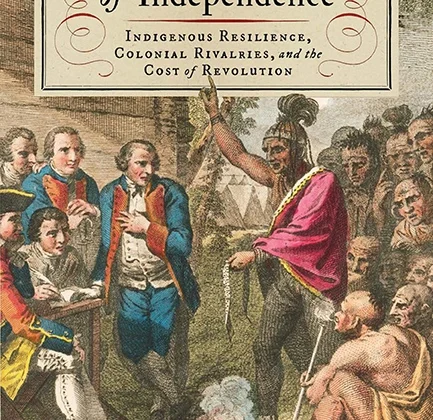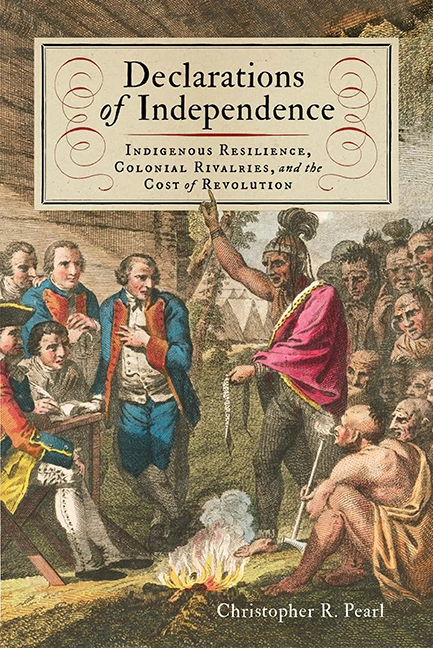

Christopher R. Pearl is Associate Professor and Chair of History at Lycoming College. This interview is based on his new book, Declarations of Independence: Indigenous Resilience, Colonial Rivalries, and the Cost of Revolution (University of Virginia Press, 2024).
JF: What led you to write Declarations of Independence?
CP: Living and working at Lycoming College, situated on the Indigenous lands this book is about, I became increasingly interested in the early history of this area and its role in the Revolutionary era. I noticed that much of the local history focused on a romanticized, settler-centric narrative of “pioneers” who supposedly formed a “Fair Play” republic and declared their independence under the shade of an elm tree on July 4, 1776. According to lore, these settlers declared independence separately of Congress—perhaps, as legend suggests, unaware of or skeptical about Congress’s own declaration that same day. This legend has a certain charm, but it overlooks the broader historical realities of the Indigenous nations who were also struggling to preserve their lands and sovereignty. For this book, I wanted to not only historicize this mythical event, but also to reframe it to include Indigenous voices and shed light on a more nuanced history of resistance, independence, and the fight for land on the revolutionary frontier.
JF: In 2 sentences, what is the argument of Declarations of Independence?
CP: In Declarations of Independence, I argue that the Revolutionary period involved competing visions of independence, with both settlers and Indigenous nations fighting to preserve their own forms of sovereignty over the land. By reexamining the myth of the “Fair Play” settlers alongside Indigenous resistance, the book provides an understanding of independence as a multifaceted and contested concept during America’s founding.
JF: Why do we need to read Declarations of Independence?
CP: Declarations of Independence invites readers to reconsider the Revolutionary period by situating the Fair Play settlers within a broader historical context that encompasses Indigenous nations’ own declarations of independence. This exploration reveals that these nations were neither passive nor silent; they actively resisted encroachments on their lands and fought for their futures. By delving into these intertwined narratives, my book offers a nuanced understanding of the diverse and often conflicting claims to independence that shaped the late 18th century. By examining both settler and Indigenous perspectives, readers will gain valuable insights into the complexity of independence as both a concept and a lived experience during the formation of the United States, highlighting that the struggle for independence was not a singular narrative but a multifaceted one involving various groups with distinct visions of what independence truly meant.
After reading this book, I also hope readers develop a deeper appreciation for the complicated nature of the Revolutionary period and the various groups whose struggles shaped its history. I believe it is essential to recognize that independence was not simply a singular ideal; rather, it was a contested concept pursued by diverse peoples and groups in revolutionary America. In my book’s case, both Indigenous nations and settlers had distinct visions of what independence entailed, often conflicting with the interests of others seeking to capitalize on “American independence.” Understanding these complexities allows us to embrace richer narratives that illuminate the various ways, means, and motivations of those who fought for independence during the revolutionary era.
JF: Why and when did you become an American historian?
CP: What an interesting question. I don’t think I have ever answered this before so please bear with me.
I’m not entirely sure when I became an American historian, but I’ve always enjoyed history. Despite a vivid memory of a third-grade assignment and a family trip to Gettysburg, I didn’t consider pursuing history as a career until after college. As a first-generation college student, I was unsure about the opportunities available to me. Nevertheless, I was fortunate to have supportive parents and to attend a small college, St. John Fisher College in Rochester, NY, where I (eventually) majored in history and had amazing professors who nurtured my passion. They also encouraged me to apply to graduate school when I felt uncertain about my future.
Despite their support, I wavered for a handful of years. After college, I found a job, bought a house, and started a family, but my love for history persisted. Eventually, while working full-time, I decided to apply to MA programs (a PhD felt far-fetched). I was fortunate to be accepted by and then work with incredible faculty at SUNY Brockport, including Owen S. Ireland, to whom I dedicated my latest book. He ignited my passion for the American Revolution, particularly in Pennsylvania, and helped me see the study of history as a viable career path. Actually, at the time in 2008, I am not sure how viable that path was.
I later applied to PhD programs and found one at Binghamton University with mentors I was excited about, including Douglas Bradburn, Diane Sommerville, and J. David Hacker. They helped turn what once seemed like a pipe dream into reality. Now, as an associate professor at a small liberal arts college, I see my position as a fitting but by no means foregone culmination of my journey. While I sometimes (or always) struggle with survivor’s guilt and imposter syndrome, I am immensely grateful for the effort it took to get here and for the high standards set by my inspiring professors, whom I strive to emulate.
JF: What is your next project?
CP: I’m excited to talk about my next project, which builds on insights from Declarations of Independence. This new work will explore a significant and troubling event from the early 1790s. It involves the descendants of the Fair Play squatters—sons of Revolutionary veterans—who committed a shocking act of violence against two innocent Seneca men hunting on land they had historically used, now claimed by these squatters as spoils of the Revolutionary War.
The case illustrates the complex aftermath of the Revolution, as the perpetrators claimed justification for their actions based on tenuous connections to their father’s death during the war. Supported by their community, they were also shielded from federal investigation and prosecution, despite President George Washington’s concerns about the potential for renewed conflict with the Seneca during a growing dispute with Native nations such as the Shawnee.
This project aims to examine this event from multiple perspectives, shedding light on its broader implications for the early United States and our understanding of justice and community relations during that period. It’s a story that highlights the ongoing struggles surrounding independence and sovereignty, and I look forward to sharing it with readers as we continue to unpack the complexities of our nation’s history.
JF: Thanks, Christopher!